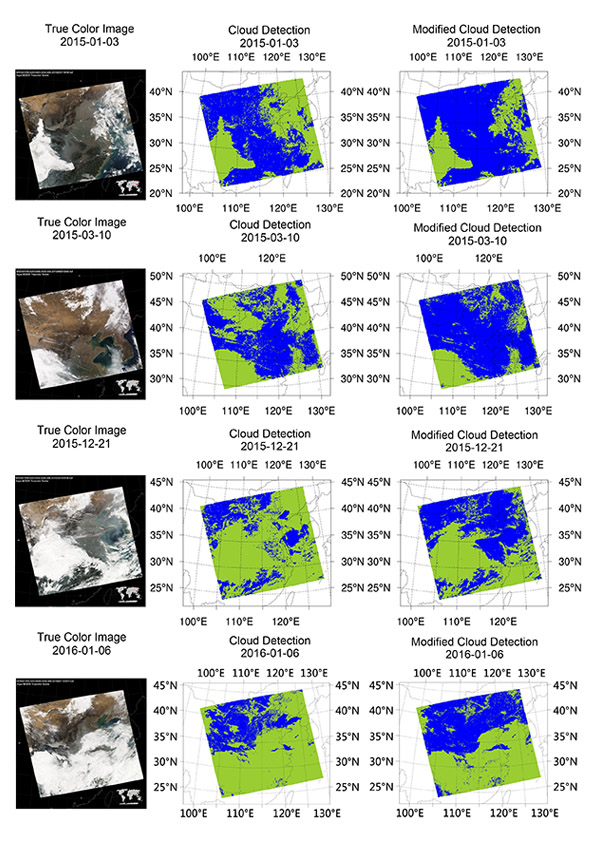State Key Laboratory of Numerical Modeling for Atmospheric Sciences and
Geophysical Fluid Dynamics (LASG)
Institute of Atmospheric Physics, Chinese Academy of Sciences

Vol.12/No.12 December 2019
Reducing the Impact of Air Pollution on Satellite Cloud Detection
Satellite remote sensing is one of the primary methods to obtain cloud physical properties. Small changes in cloud properties could impact Earth's global energy budget significantly, suggesting the accuracy of cloud detection is very important in climate research.
In recent years, haze pollution appeared frequently in eastern China, which stimulates the curiosity of Dr. ZHANG Xiao, TAN Saichun and SHI Guangyu, from the Institute of Atmospheric Physics, Chinese Academy of Sciences, about whether the most frequently used cloud products of MODIS onboard Aqua and Terra satellites are good or not in those regions. Their recent studies indicated that in the regions with severe haze pollution, such as eastern China, MODIS tended to overestimate the cloud cover largely due to the misclassification of aerosols as clouds.
To solve that problem, they developed a modified cloud detection algorithm regarding to MODIS misjudgment in haze regions, which is based on a deep analysis on the spectral characteristics of “true” and “misclassified” cloud samples for 36 MODIS bands in eastern China.
Compared with the MODIS true color images, this algorithm could effectively eliminate the misclassified “clouds”, with a mean accuracy of 97% (Figure 1). In severe haze pollution areas, this algorithm could achieve a better rectification effect and eliminate more misjudged “clouds”. After rectification, the annual mean cloud cover decreased by 13%, the mean value of cloud top height, cloud optical thickness, cloud effective radius and cloud water path increased significantly, and cloud top temperature decreased significantly.
Dr. Tan explained that high aerosol concentration would influence the shortwave and longwave outgoing radiation, and further disturb the satellite cloud observations. Reducing the impact of air pollution on satellite cloud detection could provide more accurate cloud physical properties for the researches on global and regional climate change and model simulations.

Figure 1. MODIS true color image (left), original (middle) and modified (right) MODIS cloud detections on four dust and haze days in 2015.
The studies are published in Atmosphere and Science of the Total Environment.
References:
Tan, S.C., Zhang X., Shi G. Y., MODIS Cloud Detection Evaluation Using CALIOP over Polluted Eastern China. Atmosphere, 2019, 10(6), 333, doi: https://doi.org/10.3390/atmos10060333.
Zhang X., Tan S. C., Shi G. Y., Wang H., Improvement of MODIS cloud mask over severe polluted eastern China. Science of the Total Environment, 2019, 654, 345-355, doi: https://doi.org/10.1016/j.scitotenv.2018.10.369.
E-mail: lasg_newsletter@lasg.iap.ac.cn
Editors: Chuanyi Wang (wangcy@lasg.iap.ac.cn), Kangjun Chen(ckj@lasg.iap.ac.cn)